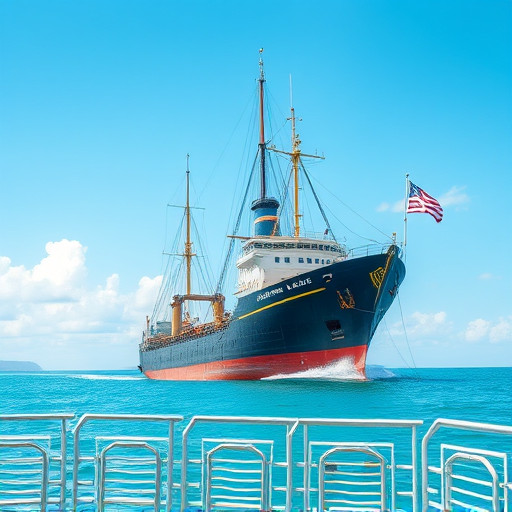TL;DR:
Ships play a crucial role in global connectivity by transporting goods, people, and resources across oceans, fostering cultural exchange and economic growth. They operate through advanced engines, propulsion systems, communication equipment, and safety measures, including lifeboats, emergency generators, and fire suppression systems. With diverse types catering to commerce and leisure, ships are essential infrastructure for modern society.
Unraveling the World of Ships: From Functionality to Global Journey
Ships have revolutionized global trade, serving as floating highways that connect continents. This article delves into the multifaceted world of maritime transportation, exploring the fundamental operations of ships and their diverse roles in modern commerce. We will navigate through the key components that keep these vessels afloat, from sophisticated systems to traditional navigation techniques. Furthermore, we’ll chart the various types of ships, uncovering their unique designs and purposes—from robust cargo carriers to luxurious passenger cruises. Prepare to embark on a journey that transcends oceans as we uncover the intricate logistics and challenges faced by these maritime marvels during their global voyages.
- Understanding the Basic Functions of Ships
- – The role of ships in maritime transportation
- – Key components and systems onboard
Understanding the Basic Functions of Ships

Ships are complex machines designed to navigate water bodies, serving various purposes such as transportation, trade, and exploration. Understanding their basic functions is crucial to grasping how they operate in different environments. At their core, ships rely on a combination of mechanical and natural forces to move.
Propulsion is achieved through engines or sails, converting energy into forward motion. Steering is accomplished using rudders, allowing ships to change direction. Additionally, ships utilize various systems for navigation, communication, and stability. These include GPS for precise positioning, radar for detecting obstacles, radios for communication, and ballast tanks for maintaining stability and draft (depth below the waterline). By mastering these fundamental functions, ships can safely navigate diverse waterways, enabling global trade and exploration.
– The role of ships in maritime transportation

Ships play an indispensable role in global maritime transportation, acting as floating bridges that connect continents and islands, facilitating the movement of goods, people, and resources across vast oceans and seas. They are the backbone of international trade, enabling the efficient transfer of raw materials, manufactured goods, and food products from production centers to markets worldwide. Without ships, the world would be isolated, with limited access to essential supplies and a stark reduction in cultural exchange.
The versatility of ships is underscored by their diverse types, each designed for specific purposes. From massive cargo vessels capable of carrying thousands of containers to sleek cruise liners offering luxurious vacations at sea, ships come in various forms to cater to different needs. This diversity ensures that maritime transportation can adapt to the ever-changing demands of global trade and leisure travel, making ships an integral part of modern society’s infrastructure.
– Key components and systems onboard

Every ship is a complex machine designed to navigate the world’s oceans with efficiency and safety, relying on a multitude of interconnected systems. At its heart, a ship boasts several crucial components that enable its operation. The engine stands as the powerplant, converting fuel into thrust through various mechanisms like steam turbines or modern diesel engines. This power is then channeled through a propulsion system, often consisting of propellers, to maneuver the vessel.
Communication and navigation are vital for safe voyages. Ships are equipped with sophisticated navigation systems that utilize GPS, radar, and charts to plot courses accurately. Onboard communication equipment, including radios and satellite phones, facilitate contact with coast guard, other vessels, and ports. Additionally, modern ships often feature advanced safety systems such as lifeboats, emergency generators, and sophisticated fire suppression mechanisms to safeguard the crew and passengers during unforeseen circumstances.
In conclusion, ships are versatile vessels that play a pivotal role in global trade and maritime exploration. From their fundamental functions to diverse types tailored for specific purposes, each ship is a marvel of engineering, combining powerful propulsion systems with sophisticated navigation tools. Whether transporting cargo across vast oceans or ferrying passengers on relaxing cruises, these floating giants embark on journeys that connect continents and enrich our interconnected world.
